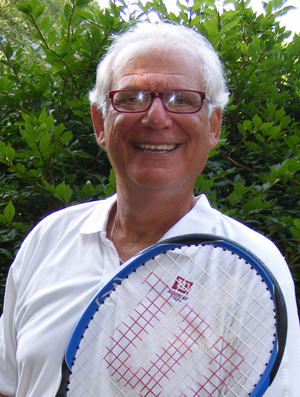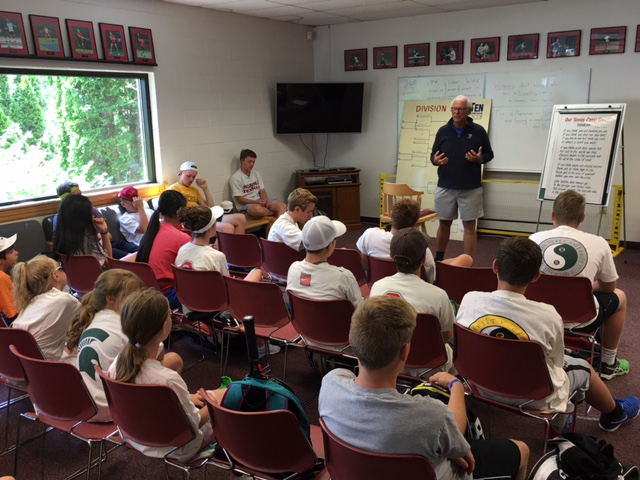The USTA Midwest completed it’s third Summit in Columbus, OH July 11-12. The purpose of the event was to add “teamwork” to the growth of tennis. Pictured left to right are Denny Schackter , Tracy Davies of the USTA National Office, Brian Parkkonen of the PTR, Jim Amick of the USTA Midwest and Jim Hendrix, Board Member of the USTA Midwest and a club owner in Columbus, OH.
Tennis Club Business: Letter to the Editor – May 2019
Tennis Priorities was recently featured in the Tennis Club Business Newsletter. Our founder, Denny Schackter, discusses his thoughts on the issues facing tennis today and how more people can learn to play at a young age.
Check out the full letter to the editor here:

Hi Rich,
You are doing great work keeping the issues facing tennis in front of everyone. It’s always fun to hear what the folks in the trenches have to say.
In looking at the dialogue about certification and seeing what has transpired thus far, it really got me thinking about how other sports have structured themselves and tennis has not.
My insurance man has three daughters, all in college now, who are, or were, outstanding youth softball players. All three could have played in college, but only one is. During their formative years, they were coached by their Dad and other fathers. The only time they saw a “pro” was entering high school and/or college softball programs. Another bud, currently a tennis director, here in Chicagoland, has a son who took a liking to hockey. His youth coach was his Dad and other parents, and I believe, still is. I am sure soccer, boys baseball, volleyball and lacrosse all have similar structures. The only two sports, to the best of my knowledge, that have a “paid pro” as youth learners, are tennis and golf.
It maybe too late, but I would love to see the USTA, PTR and PTA really get on board training parents to become tennis teachers on a more organized basis. I see NET GEN is on a push to gain more certified teachers, but the solicitation really does not specifically target parents of players. My only stipulation, if such a program was generated, is that those parents who became trained, would try their best to not work with their own children.
I do not know if this premise has been brought to your attention, but in my mind, such a program makes sense and is sorely needed based on the huge hole we have gaining adequate training for youngsters wishing to be part of tennis.
I see the need for greater continuing education and certification for current teaching pros and the solicitation and marketing of young people to enter the industry, but the low hanging fruit in the attempt to gain more qualified folks on court, are parents.
– Denny Schackter
Subscribe to Tennis Club Business here:
https://tennismediagroup.com/Newsletter.html
Be Certifiable
College Players Are Ideal Candidates to Become Certified Tennis Teaching Professionals.
By Denny Schackter
The tennis industry needs to bring in younger people. We’ve known this for many years, but as the average age of teaching professionals has climbed into the late 40s, the importance of doing so has only grown.
I’m in the business of recruiting people into this industry, and I’ve worked with college tennis players for many years. When I see former college players who have taken jobs in other professions, they often tell me “something is missing” about their new jobs. What they miss is not having as much contact with other people, like they did when they played tennis.
Both the USPTA and PTR have initiatives to bring young men and women into the tennis teaching profession, and we all should be encouraging young adults to get and stay in the industry. There are many reasons I give to college and Tennis on Campus players on why they should consider becoming certified tennis teaching pros:
Help people of all ages enjoy and benefit from tennis.
Most college players come out of school with great experiences from their time on teams. As a certified teaching pro, former college players can continue to pay this forward.
Get a handle on the tennis business.
Certified pros stay informed and updated on the tennis industry, new teaching adaptations, rules, equipment, new products, programs, facility administration and much more.
It’s a good career backup plan.
If a young person enters a profession and then later feels it wasn’t the right choice, being certified to teach tennis can almost guarantee a job.
Hone organization and time management skills.
While tennis pros work with others, they have to set their own schedules, organize their commitments and budget their time – all skills that other jobs and professions also require.
Gain and maintain a strong circle of friends.
Who do high-school and tennis players often consider their best friends? Their teammates. And these are friendships they maintain for the long term. On a staff with other tennis pros, strong friendships also blossom, and these professional connections can reap benefits down the road.
Draw out a hidden talent.
College players who enjoyed the game can be terrific teaching professionals because of the wealth of experience they gained in match play. Often, players don’t realize they can be effective teachers. Going through certification helps bring out these talents.
Stay in shape.
How many jobs give a person the chance to stay in shape? Teaching tennis is a great way to stay healthy and fit, while remaining aware of the body’s limits. This shouldn’t be overlooked.
Stay engaged in the game.
Most tennis players genuinely love this sport. Becoming a certified teaching pro keeps players connected to it.





